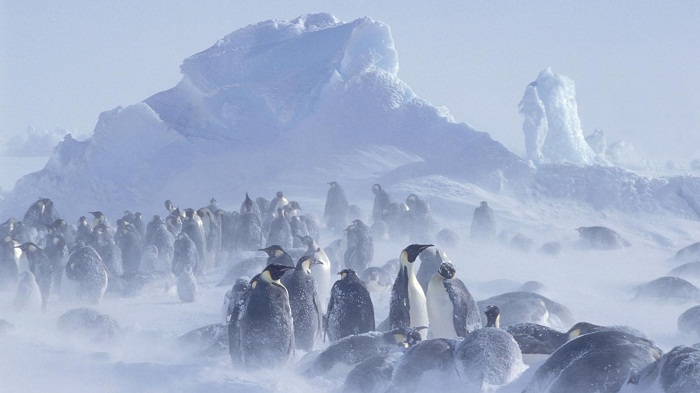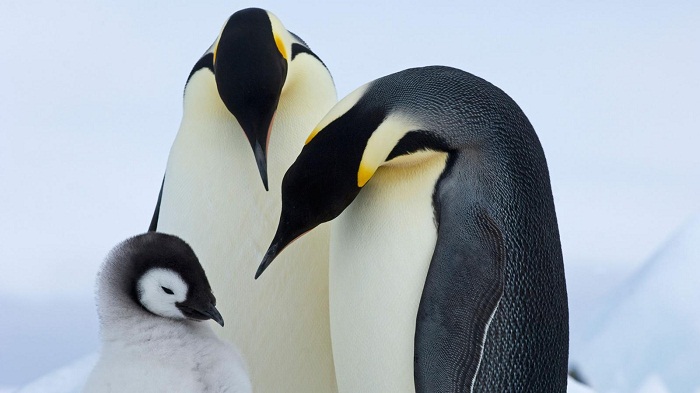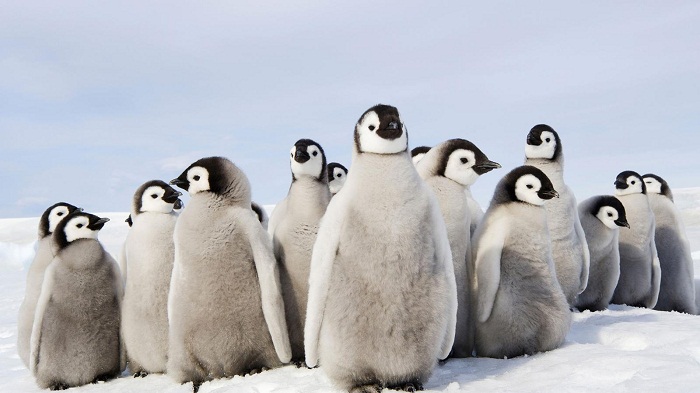Reality: Most penguin species live in temperate or tropical places. They frequently cheat on their partners and engage in homosexual acts. Penguin mothers kidnap each other`s chicks.

In 1911, the English explorer Captain Robert Scott sent three men from his Antarctic base on a mission: to collect three emperor penguin eggs. But it was the middle of winter. As temperatures plunged to -60 °C the youngest explorer, Apsley Cherry-Garrard, shattered most of his teeth by chattering in the cold.
Cherry-Garrard could have been forgiven for resenting the birds. Instead, he was enchanted. He later wrote that the knee-high Adélie penguins living around their camp were like funny little men "late for dinner, in their black-tail coats and white shirt-fronts" – although this did not stop him eating them.
Over a century later and the world has gone penguin-mad. We are delighted by their upright waddling, flappy arms, ridiculous fluff-ball chicks and adults that get around by tobogganing.
Yet we have a long history of getting them wrong.

Early explorers thought penguins were fish, then quickly changed their minds: they were plainly half-way between fish and birds. By Scott`s day the leading theory was that penguins had not yet evolved to fly and might be the missing link between birds and dinosaurs. It was hoped the answer would be revealed by studying their eggs.
We now know that the first penguins waddled the Earth around 70 million years ago.
Their ancestors lost the ability to fly as they became better swimmers; their bones became heavier to help them to dive. Now they "fly" underwater at speeds of up to 25 mph (40 km/h), reaching depths of more than 500 m (1640 ft).
Which brings us to where they live, and on this point we need to get a few things straight.

Except for one rogue bird that overshot it on a fishing trip in 1956, there are no penguins in Madagascar. As we have pointed out before, there are also no penguins at the North Pole. Almost every penguin that has ever lived has done so in the Southern Hemisphere.
They are famed for living at the end of the Earth, but most penguins do not live in Antarctica. They evolved during a heatwave and the oldest known penguin lived in New Zealand, when the surrounding ocean was like a warm bath. By 42 million years ago, giant penguins roamed Peru.
To this day, over half the world`s penguin species prefer temperate or tropical climates, and the Galápagos penguin lives on the equator. Of the 18 species, only emperor and Adélie penguins breed in Antarctica.
Where polar penguins win out is in sheer numbers. Macaroni penguins live a long way south and breed in colonies 100,000 strong.
Antarctica`s Emperor penguins are so numerous, they can be counted from space. Their colonies have been located by looking for brown patches of penguin poo on satellite images. These studies revealed that there are twice as many emperors as was thought.
In contrast, the species living near humans face threats on all sides, from overfishing and oil spills to feral cats, so they tend to be less numerous. The Galápagos penguin numbers fewer than 2000.
Then there is penguins` cuddly reputation. In recent years, facts have emerged that would make Pingu`s feathers stand on end.

In 2012, Douglas Russell of the Natural History Museum in London, UK unearthed a paper called "Sexual Habits of the Adélie Penguin". It was labelled "not for publication".
The paper was the work of George Murray Levick, Scott`s expedition scientist and the first person to witness an entire breeding season. He was shocked by what he saw: gangs of males engaging in homosexual sex, sexually abusing chicks, and mating with dead females. At the time, the material was judged too depraved for public consumption.
Though it was alarming for an Edwardian Englishman, the behaviour was entirely within the realms of biological normality. The "hooligan" males Levick observed were probably sexually inexperienced and making mistakes.
This sort of thing does happen. In recent years, fur seals have been discovered trying to have sex with penguins on at least four separate occasions, and this may also be a simple mistake.
The other Antarctic species, the emperor penguin, is if anything even worse.

Female emperor penguins that have lost their own brood frequently "adopt" unattended chicks. If there are none available, things get violent. Fights break out as mobs of broody mothers struggle with each other to steal a chick from another penguin family.
Kidnappings last from a few minutes to a few days. Most end with the chick being abandoned to die in the cold. One confused penguin even kidnapped its own natural enemy, the chick of a penguin-eating bird called a skua.
These kidnappings are bizarre and brutal in equal measures, and why the females do it has been puzzling scientists for decades.
Emperor penguins are unique among birds, in that they nest in the middle of winter. The females must go to sea to feed, leaving the males to keep their offspring warm. This causes a problem. When most birds lose sight of their eggs, they stop producing the parenting hormone prolactin, and lose interest.
To maintain their maternal instinct during their 2-month vacation, emperor penguin mothers maintain high levels regardless. Frédéric Angelier of the French National Center for Scientific Research in Villiers en Bois wondered if this hormone might explain the kidnappings.
To find out, Angelier and his colleagues injected birds that had lost their chicks with bromocriptine, a chemical known to suppress prolactin. As they expected, these penguins kidnapped chicks less often than control penguins that did not receive bromocriptine.
"It`s a by-product of their very special strategy," says co-author Olivier Chastel. "If you are back from the sea and there is no chick, you still have this really high hormone level and you are likely to grab a chick."

Finally, penguins have a reputation for romance, and this too is not really deserved.
Emperor penguins form long-distance relationships that endure the Antarctic winter, and this has made them the poster children of monogamy. The penguins themselves have different ideas, and regularly get "divorced". Similarly, 81% of king penguins choose a different mate every season.
Infidelity is also commonplace. Nearly a third of female Humboldt penguins cheat on their partners.
This cheating is sometimes driven by factors that, to us, seem shockingly mercenary.
Adélie penguins build nests out of stones, and a shortage of stones has pushed many females into "prostitution": they mate with other males in exchange for stones. Some duplicitous females have started going through the elaborate courtship ritual to get the stones, and then running off before the male can mate. Both sexes also steal stones from their rivals` nests.















































